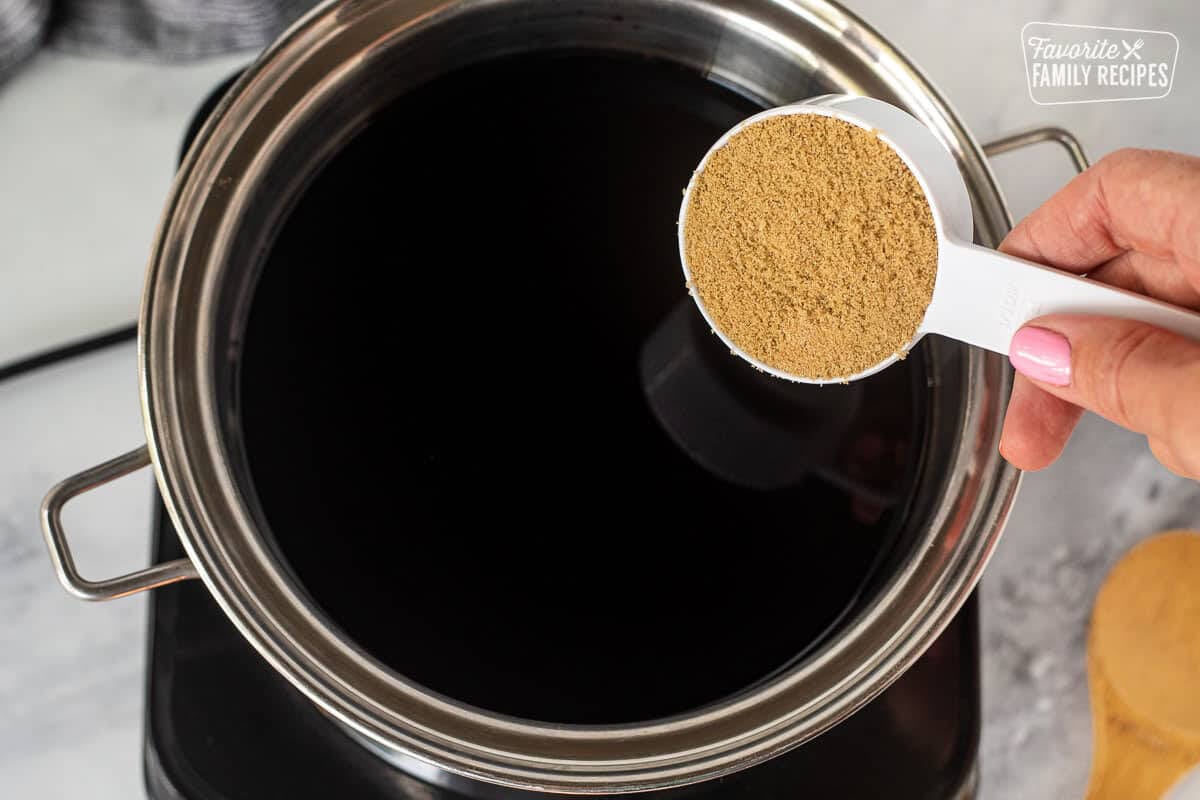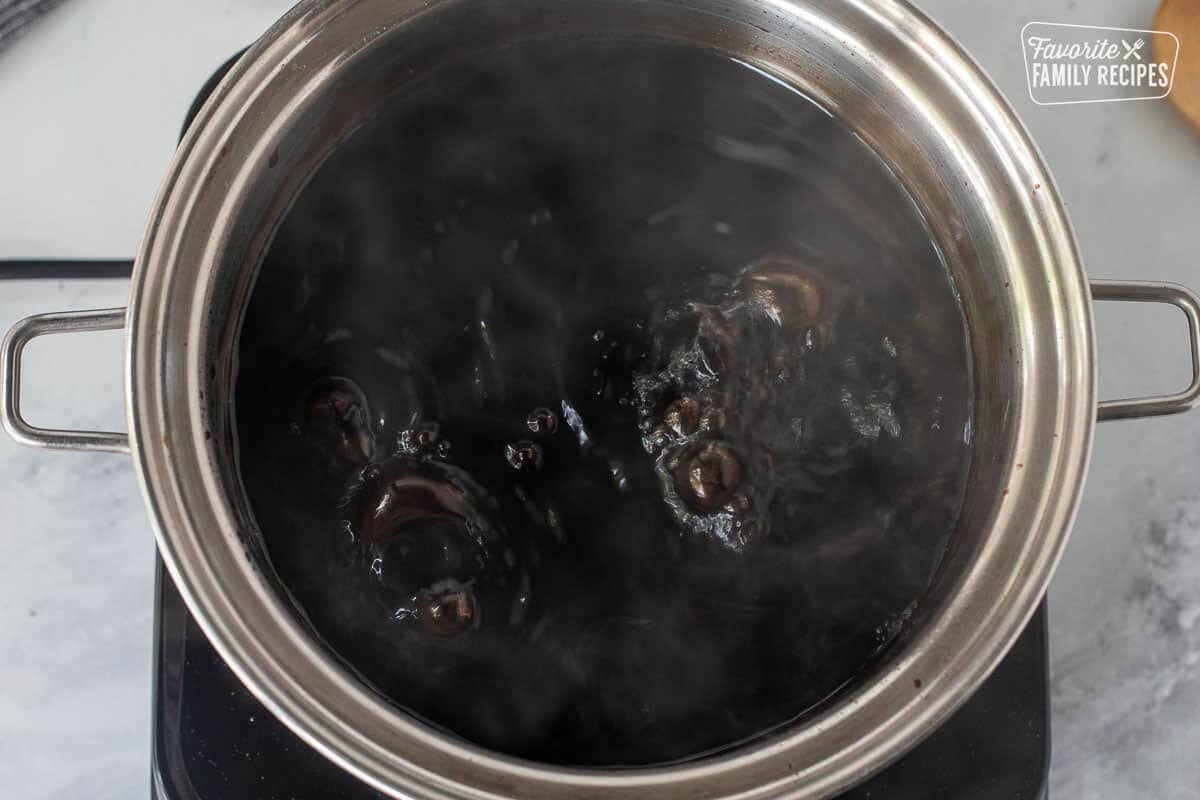We may earn a commission when you click on the affiliate links in this post.
This easy balsamic glaze is made with just two simple ingredients. It goes well on just about anything from fresh veggies to grilled meats to pizzas and more!

Balsamic glaze, aka balsamic reduction, is one of those things that I put on just about everything. The sweet, bold flavor brings life to so many dishes. I am not exaggerating when I say it is a daily staple at my house. At any given time, you can always find a jar of it in my fridge.
Although balsamic glaze is becoming increasingly popular, sometimes it can be tricky to find at regular grocery stores. And when it is available, it can be pricy. Luckily, balsamic vinegar is relatively cheap and making balsamic glaze at home is a breeze! I actually think my homemade recipe is better than the store-bought glazes because it is more fresh and I have complete control over my preferred thickness. If you are a balsamic glaze lover like me, you are definitely going to want to memorize this recipe (don’t worry, it’s an easy one to memorize).
How to Make Balsamic Glaze
Balsamic glaze requires only 2 ingredients: balsamic vinegar and brown sugar. That’s it. Now that you have your ingredients, the steps to make it are as easy as 1-2-3:
- Combine ingredients: First, combine the ingredients in a heavy saucepan and bring to a boil over medium heat.
- Reduce heat and simmer: Next, reduce the heat to medium low and keep it between a low boil and a simmer, stirring occasionally until it has reduced by a little more than half.
- Cool: Finally, remove from heat and allow it to cool to room temperature. If you want to store it for later, transfer to a jar and refrigerate.
Balsamic Glaze vs Balsamic Vinegar
Balsamic vinegar is a thin liquid that has a rich, tangy taste, perfect for salad dressings and marinades. Balsamic glaze, on the other hand, is thicker and sweeter. It is made by reducing balsamic vinegar often with a sweetener like brown sugar, until it becomes syrupy and concentrated. This intensifies the flavors, which makes it ideal for drizzling over just about anything. Both are delicious, but they bring different textures and flavor profiles to your recipes!
What Balsamic Vinegar is Best?
In Europe, to make sure you are getting the best of the best, certain foods and ingredients are labeled with a “D.O.P” or “P.G.I.” label. D.O.P. stands for Denominazione di Origine Protetta, which translated means “Protected Designation of Origin” and P.G.I stands for “Protected Geographical Indication”. These let consumers know that these foods and items are guaranteed to be authentic and actually come from where they say they come from. They are true labels of quality. In the images below you can see what the labels look like on different items. When looking for the most quality balsamic vinegar, look for “balsamic vinegar of Modena” with these labels.
Balsamic Glaze Uses
When it comes to foods that go well with balsamic glaze, the possibilities are endless. No joke, I put it on roasted vegetables, Brussels sprouts, caprese salad, green salads, sandwiches, pasta, pizza, grilled chicken or steak, and the list goes on and on. It doesn’t even have to be anything fancy. Most of the time I just find myself drizzling it over slices of fresh garden tomatoes. It is so good! You really can’t go wrong any way you serve it.
How to Store Homemade Balsamic Glaze
Homemade balsamic glaze can be stored for up to 3 months in the refrigerator when stored properly. Once the glaze has cooled completely, place it in an airtight container such as a glass jar with a lid and refrigerate. That’s it! If you find that it has thickened too much in the fridge, just add a little bit of water or more balsamic vinegar to thin it out to your desired consistency.
Tips and Suggestions
Have good ventilation – Any time you make a vinegar reduction it is going to have a strong smell, not a bad smell necessarily, just a strong one. Be sure to turn on the vents above the stove, open windows, or have a fan going. This will help keep your house from smelling like balsamic vinegar for hours.
Check the thickness – Until you have made this recipe a few times, it may be difficult to determine the correct thickness while it is still hot. Since it will thicken a lot when cooled, get a spoonful and let it cool on a plate in the fridge. Check after the glaze has cooled completely to see the actual thickness.
Swap out the sugar – Feel free to experiment and swap out the brown sugar for honey or even agave syrup. Personally I like the taste of the brown sugar best, but both of these substitutions still taste amazing.
Adjust the ratios – Do you prefer a sweeter reduction? Add a little more sugar. Like it more tangy? Reduce the sugar by ¼ cup. Once you make this a few times you will discover the ratios you like best. Feel free to make it to your own taste!
Try a different flavor – My very favorite balsamic glaze ever is a lemon balsamic that I found in Italy. When I ran out I was so disappointed but I figured out I could easily get the same flavor by just using a lemon flavored balsamic vinegar. There are so many different balsamic flavors out there such as fig, pear, raspberry, orange, and even chocolate! Any of these would make an incredible reduction.

Balsamic Glaze
Video
Equipment
- Small Saucepan
Ingredients
- 2 cups balsamic vinegar
- 1/3 cup brown sugar (or honey)
Instructions
- Add balsamic vinegar and brown sugar into a small saucepan.
- Bring to a boil over medium high heat. Reduce heat to medium low.
- Simmer uncovered, stirring occasionally, until it has slightly thickened and reduced to about 1 to ¾ cup. This could take anywhere from 15-30 minutes. Remove from heat.
- As it cools, it will thicken a little more. Store in a jar that has a lid or any airtight container.
- It will also be thicker if you store and use it from the refrigerator.







Made this as per the directions, and the taste was fabulous! Live at 7,000 feet altitude, so it took a few minutes longer than I expected to reduce down. Going to make this for take-along gifts.